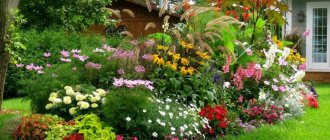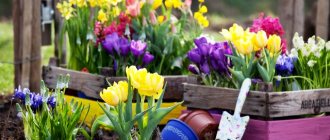Autumn is a great time for planting various vegetable, berry and fruit crops. But with particular success this season you can plant perennial flowers, especially bulbous ones.
Below you will find information about which perennials can be planted in the fall in your country house or garden to get a beautiful flower bed. Video and photographic materials are also waiting for you.
Benefits of autumn planting perennial flowers
The first and most pragmatic argument in favor of autumn planting, replanting, and sowing perennial flowers is the freeing up of significant time in the spring, when there is a lot of other work on the site.
When deciding what planting time to choose, you cannot miss the fact that in the spring perennials begin to actively grow. The period for planting them before the start of the growing season turns out to be extremely short.
In addition, there are some features of flower plants planted in autumn:
- they begin to bloom in the first year after planting;
- overwintered plants undergo natural hardening, and the seeds undergo stratification, so such flowers, in comparison with those planted in the spring: have stronger seedlings;
- less susceptible to spring frosts;
- bloom 2–3 weeks earlier;
- less susceptible to diseases and pests;
Some plants can be planted and replanted exclusively in the fall. This is due to the fact that in the spring their roots simply do not grow. An example would be the Siebold and Tokudam hosts.
Hostas Siebold and Tokudam are planted only in autumn
Choosing a location for a future flower garden
What perennial flowers can be planted in the fall in the garden? There are quite a lot of varieties of perennials, the main thing is to decide on the placement of the flower bed and only then choose varieties.
Convenient location
The best places to plant flowers in the fall in open ground:
- along garden paths;
- in the front garden;
- near the terrace;
- under the fence;
- at the edge of the lawn.
The length of the flower bed is chosen arbitrarily, taking into account the specifics and shape of the site - the optimal indicator is a distance of 1-3 meters. You also need to take into account the cardinal directions, color relationships, and the features of caring for all plants in the flowerbed.
Where and what to plant in the selected area for a flower bed
| Cardinal directions | What to plant |
| South | Sun lovers |
| West | Shade-loving |
| North | Plants that cannot tolerate large amounts of light as much as possible. |
| East | Moisture-loving, needing light. |
What are the risks of autumn planting?
Autumn planting of perennial flowers can only cause concern for gardeners who have little experience in growing these plants. After all, the main risk is the delay in planting flowers, which will not have time to take root well, and therefore will suffer from the cold, or even die in winter.
When planting perennials in autumn, the opposite mistake is also possible - placing the plant in the ground too early, when prolonged warmth will provoke the growth of shoots, and with the advent of frost - the death of the young shoots.
The only advice that can be given to gardeners is to coordinate transplants not only with the local climate and advice on the Internet, but also with the long-term weather forecast for the current season, as well as the ability of specific plants to tolerate low temperatures.
It is better to replant flowers in dry and relatively warm (+12…+15ºС) weather. In such conditions, well-watered plants will feel comfortable in a new place and will take root more easily. Flowers with low winter hardiness should be covered with peat, sawdust, spruce branches, and fallen leaves for the winter.
Soil preparation
Quite a large number of flowers can be planted in the fall at the dacha, but first of all you need to prepare the soil. It is worth considering that seed planting usually occurs in late autumn, and by this time all preparation procedures must be completed.
Preparation stages:
- Choosing a space for a future flower bed.
- Cleaning up trash, weeds and old organic matter.
- Digging up the ground to stimulate the growth of weeds and their subsequent destruction.
- Carrying out deep digging of the earth to get rid of pests.
- Arrangement of the site - plants planted with seeds in the fall should not die due to the fact that the planting material was washed away by melt water.
- Repeated deep digging of the soil to saturate it with oxygen.
- Preparing mixtures of sand and peat or compost for planting.
October planting of perennials
The first half of October is usually still accompanied by weather that makes it possible to continue planting and replanting those perennial flowers that the gardener for some reason did not have time to work with in the second half of September.
The end of October is already cooler. The weather of this period allows you to plant lilies of the valley. Today it is not only the May lily of the valley, which symbolizes spring, and is known to everyone, but also various breeding varieties, up to a variety that has pink flowers. The May lily of the valley is not afraid of cold weather and overwinters without shelter even in the 3rd frost resistance zone of plants, where minimum temperatures range from -43 to -34ºС. When purchasing varietal lily of the valley, it is better to check its wintering conditions.
All parts of the lily of the valley are poisonous, so you need to wear gloves when working with this plant. The fruits - bright berries - are best removed, especially if there are children on the site.
The May lily of the valley is not afraid of cold weather and winters without shelter
During the same period, bushes of peonies that have become too large are planted - deciduous herbaceous perennials that make up the only genus of the peony family. Now there are many varieties of these flowers. They are very diverse, including tree-like peonies that have the shape of a bush.
Peonies are deciduous perennials that form the only genus of the peony family.
Flowers that can be planted in autumn: names and descriptions
There are many perennials (and biennials) that you can successfully plant in the fall and enjoy their beauty in subsequent seasons. With their help, you can improve the garden area, bring brightness and festivity.
Perennials for planting in autumn
Many perennials are planted by seeds and by dividing the bush. Below you can explore the most interesting and beautiful specimens.
Primrose
There are more than 500 types of beautiful primrose. Flowering occurs at different times depending on the species, but, as a rule, this flower is considered a spring bloomer.
The optimal location of a flower bed with primroses is in partial shade, which comes from trees and bushes. The soil should be fertile and moist. The recommended time for planting a flower in the garden or country house in the fall is the end of September.
Advice! You can find all the detailed information about planting primrose on this website .
Heuchera
Heuchera is an amazing plant that can change the color of its leaves during the growing season. Interesting shades and their combination on the leaves attract the attention of even the most experienced gardeners. Heuchera is often used to create flower beds near the house, alpine slides, and stone flower beds .
Heucheras are suitable for light, nutritious soils with permeable properties. You should not choose areas where moisture stagnates.
As for the growing area, the opinions of experienced gardeners differ: some say that it is best to root in a sunny place, others say that a shaded bed is more suitable. Therefore, you can choose a place with partial shade or with good lighting and protection from winds and cold.
It is optimal to replant heuchera in the autumn after flowering. Delenki should be mulched to protect them from cold weather.
herbaceous peony
Many gardeners love the beautiful and unpretentious herbaceous peony that blooms in spring. For rooting, you should choose sunny, well-lit areas. But it is also important that there are bushes or small trees nearby that can protect the peony from bad weather. Areas in lowlands where moisture stagnates should be avoided.
Suitable dates for the event are the end of August-beginning of September (but if the season is warm, then the procedure can be carried out until the end of September).
Important! You can study more detailed information about planting peonies in this article .
Rudbeckia
Sunny areas are suitable for rudbeckia. It is not recommended to grow it in one bed for more than five years, so after this period it is better to replant it. It is optimal to do this in the second half of September after flowering. But it is better to sow seeds in the spring.
Phloxes
Beautiful summer flowering perennials. The place for planting them should be chosen as sunny, with moist soil, preferably loose and fertile.
Phlox can be planted and replanted in September-October. But if you did this too late, then you need to mulch the bed after the event. You will find details about sowing phlox seeds in this article .
Hosts
Hosta is a shade-loving plant, which is called the “queen of shade”, so it must be planted in a shady area.
By the way! You can read about other shade-loving and shade-tolerant plants this material .
Hosta also loves humidity, but excess moisture still needs to be excluded. It looks very beautiful both during flowering and after (thanks to the magnificent leaves).
It is better to replant hostas on a cloudy day. This must be done no later than a month before frost.
Delphinium
The color of the delphinium is very diverse and can vary from soft pink to bright blue. In the southern regions of the country it blooms in May-June and blooms again in the fall. As for central Russia, flowering occurs in the summer - mid-June and lasts until the end of July. It can resume provided that the flower stalks are cut off after the first flowering.
The first half of September is the optimal period in the fall when you can plant or transplant a flower into open ground. For planting, it is better to choose a sunny, spacious place. The soil must be fertile. By the way, if it is sandy or clay, then it is recommended to fertilize it well. Before autumn planting or replanting, it is necessary to dig up the soil and apply organic fertilizers.
Interesting! Also read how to plant delphinium seedlings in this material .
Echinacea
Echinacea blooms from July to September. But for successful cultivation and lush color, it is necessary to root Echinacea in a sunny place. Do not place echinacea too close to other plants.
Planting by transshipment can be carried out until late autumn. But you should first grow seedlings from seeds in winter.
Astilbe
A beautiful, unpretentious perennial. At the same time, delicate and bright astilbes can decorate any area. The color of astilbe can be pink, white, purple, red. Summer flowering dates vary from June to August.
The best time to plant a flower in the fall is early September. If you plant astilbe at a later date, it is imperative to mulch and cover it before winter.
Before the event, the soil is dug up, weeds are removed, and fertilizing with rotted manure is carried out. But after planting, it is necessary to mulch the astilbes; for this you can use sawdust and straw.
Important! Detailed information about planting astilbe awaits you in this material .
Chistets woolly
Woolly chickweed is also called sheep's ear because of its large, hairy leaves. It is because of their beauty that chistets have become popular among summer residents and gardeners. It blooms from June to September, but the flowering is inconspicuous; they love it precisely for its foliage.
Planting by dividing the bush is best done in the fall, when the heat has passed . But sowing the seeds of the woolly chickweed can be done in autumn, summer, and spring; in this regard, the woolly chickweed is unpretentious.
A suitable place for the woolly guillemot is a sunny or semi-shaded area without stagnant moisture with light, loose soil that drains well. With an abundance of sunlight, the woolly chick will be more silvery and shiny. It is better to give sheep's ears some free space and not plant too close to other crops.
Loosestrife point
An unusual specimen with bright, juicy flowers will look great either alone or next to other plants in a flowerbed. Loosestrife blooms from late June to mid-August. It is worth replanting it about once every three years, because it grows quickly and can begin to crowd out other “inhabitants” of the garden.
It is best to plant and replant loosestrife in September or October. The soil should be moist at the time of deepening. It is also important that there are no young leaves on the dotted loosestrife.
The most suitable site for planting point loosestrife will be a spacious place with high humidity and fertile soil.
Dicentra
A colorful and delicate dicentra, reminiscent of a heart, will become a bright spot even in the most boring area. The flowering period of dicentra varies from early spring to late summer.
The plant is moisture-loving, so it is recommended to plant it in moist, fertile soil with good drainage. But it is important that there is no stagnation of moisture in this area, this can lead to rotting of the roots.
You can plant a flower in the fall anywhere, because any area in the garden is suitable for growing. With an abundance of sunlight, flowering will begin earlier, but there is a risk that the dicenter will be low.
If you plan to plant a flower in open ground by dividing the bush, then it is recommended to prune it in the fall before digging the dicenter.
It is important that the dicentra has time to take root before the onset of cold weather, so it is necessary to plant it in the country house or garden in September.
Garden yarrow
Garden yarrow can delight with its color almost all summer. And it blooms beautifully!
Garden yarrow should be planted and replanted in a sunny place. It is better to plant garden yarrow in the fall rather than in the spring because it loves the cold. Sowing of seeds is carried out before winter; it should be sown on the surface, and it is recommended to sprinkle a small layer of earth on top.
Lupins
The perennial is suitable for those gardeners who love beautiful but unpretentious crops. Beautiful lupine can be white, purple, pink, red, blue, yellow.
Lupins are light-loving plants, so you should not root them in shady places. Sowing seeds in open ground can be done in late October-early November. It is best to transplant a flower in a garden or country house in early September.
Brunner
Beautiful, laconic and unpretentious, Brunnera will look great as a decoration in flower beds, near paths and near fences. But please note that this plant is moisture- and shade-loving, so the planting location in the country house or garden should be chosen taking these features into account. Spring flowering of Brunnera begins in late April-early May and lasts about a month. If the autumn season is warm, then re-blooming is possible.
It is best to carry out autumn planting and replanting of brunners in the country house or garden in early September. If the event is carried out too late, then hilling must be carried out. It is also best to carry out the procedure in the evening or on a cloudy day.
Brunnera is exactly the flower to plant in the fall. It is highly not recommended to carry out a gardening event in the spring; planting and replanting in the spring is only allowed for large-leaved brunners.
Poppy
Poppy is a light-loving plant, so it needs to be sown in a well-lit area. For colorful poppies, stagnation of moisture in the soil is categorical, so the site must be with deep groundwater. Poppy can be grown on any soil, but crumbly light soils - loam, sandy loam - are most suitable for it.
The photo shows bright and magnificent poppies:
Planting poppies with seeds is possible not only in autumn, but also in spring. However, if you sow in the autumn, you can enjoy flowering at an earlier date.
perennial aster
The beautiful perennial aster can have different colors - red, white, yellow, purple, pink, lilac. Therefore, with the help of perennial asters, you can create elegant, rainbow-colored and bright flower beds.
Depending on the species, flowering occurs in different periods: for early asters - in May-June, for summer asters - in July-August, for autumn ones - in September-November.
Perennial aster should be planted with seeds in open ground in November-early December. It is best to do this when the soil is slightly frozen. And in the spring, when there is an abundance of seedlings, they can be planted in a permanent place. You can plant or replant a plant in the garden or at the dacha until late autumn before the soil freezes.
An unfavorable place for an aster is a damp area with stagnant moisture; in such a place, the roots may rot. It is best to plant the aster in a well-lit, sunny area. If this is not possible, then growing in partial shade is acceptable. But you shouldn’t do this in complete shade.
Pyrethrum
Pyrethrum is shaped like chamomile, but is surprisingly colorful and rich. Flowering occurs in June-July. Growing is possible on any soil, but it must be loose. The place should be well lit by the sun. It is recommended to sow seeds in mid-September.
Nivyanyky
At the first meeting, the cornflower may give the impression of a simple and uncomplicated flower. But the impression is completely deceptive, because elegance and unusual, pure beauty are hidden in the nivyanika.
The combination of bright yellow and bright white will brighten up any flower bed. Nivyanik is an unpretentious plant that is easy to care for.
When rooting in the spring, there is a risk that it will not take root, so autumn is the most optimal time for planting cornflowers in open ground. The place for planting in a country house or on the site of a private house should be sunny, with drained, loose soil, the site should not be excessively damp.
Biennials suitable for autumn planting
Not only perennials can be successfully planted in the fall. You can safely carry out the procedure and get a wonderful result with biennials.
Aquilegia
Unpretentious in terms of care and very interesting, the plant has several names - orlik, columbine. Flowering times may vary depending on the variety, but for many it begins in early June.
Planting aquilegia in the fall is done by sowing seeds. It is optimal to grow in moist, loose, light soil. It is possible to grow in both sun and partial shade, but the plant will be most comfortable in partial shade.
Stock rose (Mallow)
Colorful mallow looks most decorative and harmonious next to fences and buildings, and is suitable for the role of a hedge. Planted lengthwise, it adds coziness and liveliness to the area.
Mallow seeds are sown in May, and the plant is planted in a permanent place in early September.
Turkish clove
Exquisite Turkish carnations can have different colors: pink, white, burgundy, red. It is not only distinguished by its magnificent appearance, but also has a very pleasant aroma.
Read all about growing Turkish cloves from seeds .
Bulbous perennials planted in autumn
Autumn is a great time to plant bulbous perennials. If you carry out gardening activities according to all the rules, then they will delight you with their beauty for a long time. For planting, you need to choose healthy bulbs, without wilting, without the smell of mold or any rotten areas.
Crocuses
Beautiful crocuses also have another name - saffron. These bulbous plants have bright, rich colors, making their blooms look simply fabulous. In spring it can occur in March, April, May.
Crocuses thrive in sunny beds, but they can also be grown in areas with diffuse shade. It is also worth choosing areas with permeable and loose soils. The optimal time for planting such bulbous flowers in the fall is September-October. But please note that before winter, those crocuses that bloom in the spring are planted, and those that bloom in the fall - in the summer.
More detailed information about planting crocuses awaits you in this material .
Tulips
Tulips come in a huge variety of colors, sizes, and varieties. Thanks to this, every summer resident and gardener can find the perfect tulip for their garden. Flowering of such a bulbous plant usually occurs in April, May, and June.
It is recommended to plant these bulbous flowers in the fall, when the temperature is around +7-10 degrees (usually late September-early October).
It is best to plant in sunny areas that are protected from the wind. The soil should be loose, permeable with good drainage properties. Stagnation of moisture in the garden bed is unacceptable.
Note! You will find instructions, tips and recommendations regarding planting tulips in the fall before winter this article .
Lilies
An elegant bulbous plant can have different colors. Flowering may occur in June, July, August. Experienced gardeners recommend growing lilies in a sunny bed that is protected from the wind. The soil must be fertile, loose with good drainage properties.
Planting is best done in September.
By the way! You can read about transplanting and planting lilies in the autumn here (transplanting) and here (planting).
Hyacinths
Hyacinths also have another poetic name - “flower of rain”. For them you need to choose beds that are protected from the wind, well lit by the sun and in which moisture does not stagnate. Hyacinths should not be planted on dense and acidic soils. The proximity of hyacinths to other crops is not recommended.
Approximate flowering time is April-May. And the optimal time for autumn planting of these bulbous flowers is the end of September and the beginning of October.
Important! Detailed information about planting and growing hyacinths is contained in this article .
Muscari
Muscari is not the only name for a beautiful blue plant. It is also called “mouse hyacinth” and “viper onion”. The deadline for autumn planting of muscari is the end of September, October.
Muscari is unpretentious in cultivation, but nevertheless you should know some of its features: it can be rooted both in the sun and in partial shade, stagnation of moisture should be avoided, the soil should have good permeable properties. Flowering time varies from April to May.
Daffodils
Daffodils love sunny places; it is also important that the bed is protected from the wind. Lovely daffodils bloom in April and May.
Note! More details about the nuances of planting daffodils are described in this material .
Delphinium
For winter planting, only fresh seeds should be used. Light, loose soil is suitable.
The area should be well lit by the sun and protected from wind and drafts.
Deepen the material 2 cm, after which you should cover it with a layer of mulch.
Iberis
Iberis looks original on the site. This plant can be used to frame a lawn or flower bed.
You should not actively care for Iberis. The only caveat is to protect plants from root rot. Therefore, it is better to plant among stones.
Phlox Drummond
This plant is an annual crop. It is frost-resistant, so it can be sown before winter. Consider in advance that in the case of early spring, sprouts will appear quickly and may die if frost returns. It is advisable to cover phloxes after sowing seeds.
The shelter can be made quite simple. Stretch small arcs and cover them with film. You can also cover it with wooden boxes covered with film.
Godetia
If you don’t know what annual flowers can be used for winter sowing, this plant is well suited for decorating flower beds. Sowing seeds should be carried out in regions with warm winters.
Choose well-lit areas. The soil must be fertile. Then lay a layer of mulch to protect the flowers from frost.
How to properly design flower beds with conifers: the best compositions and combinations of plantsAnnual flowers for a flower bed or garden: photos with names
Bush hibiscus: photo, planting and care features
Alyssum marine
If you sow flowers in winter, you can get strong seedlings that are not afraid of winter frosts. It will adapt to open ground conditions.
Seeds should be sown in loose soil with neutral acidity. Considering that the material is too fine, sowing should be carried out in soil mixed with river sand. First freeze it a little, and after planting, cover it with a layer of mulch.
Cosmea
These flowers are characterized by excellent beauty and ease of care. The peculiarity of this crop is that it can reproduce by self-sowing. In the spring you will need to remove excess shoots.
Planting should be done in well-lit areas with well-drained soil.
In nutritious soil, plants only increase green mass, which negatively affects flowering.
Aster annual
You can plant an annual aster in the fall before winter. It blooms early and decorates the garden. Sowing is carried out in well-lit areas. The soil should be loose, with neutral acidity. It is better to plant in places where marigolds and calendula used to grow.
Raise the bed slightly to a height of 15 cm. This way you can avoid stagnation of water. Water the furrows with a solution of “Fitosporin” or “Maxim” to prevent the development of fungal diseases.
You need to deepen the seeds by 2 cm, and sprinkle dry soil on top. To protect from frost, cover them with peat or sawdust.
Lavatera
This plant is also called “wild rose”. The flower is unpretentious in care. It can be planted before winter in flower beds, along borders or in containers. However, sowing should be carried out in well-lit areas where loose, light soil predominates. If the soil is depleted and poor, you can add mineral fertilizers.
Sowing seeds can be done immediately in a permanent place. Before winter, the area should be mulched.
Is it worth planting flowers in flower beds before winter?
When postponing planting flowers until autumn, gardeners are guided by the following considerations:
- the plant development cycle turns out to be as close as possible to natural due to natural stratification;
- “natural selection” occurs: the weakest plants die in winter, the survivors have better immunity and are more resistant to the vagaries of the weather;
- there is no need to waste time and effort on growing seedlings; space is freed up on the windowsills for other crops;
- flowering begins 7–15 days earlier than when planting in spring (seedlings, unlike seedlings, do not require time to adapt to new conditions);
- at the beginning of spring, pest activity is minimal - the seedlings will not be damaged at a time when they are most vulnerable.
The main disadvantage of winter landing is that you need to be able to choose the right time. Plants must form a root system, but not have time to grow. Otherwise, they are guaranteed to freeze. There is always a risk of returning spring frosts, especially in the Urals, Siberia, and other regions with an unpredictable climate.
You can start creating a beautiful flower bed in the fall
alpine aster
It is not difficult to grow alpine aster from seeds. Sowing can be carried out both before winter and in May. The first option is preferable, because after cold stratification, germination rates improve. Given the small size of the material, it is first sown in containers and then dug into the soil.
Choose well-lit areas for alpine aster. Planting in partial shade is acceptable.
Give preference to raised beds to prevent water stagnation. After planting, cover the area with a layer of humus and mulch.











